Let’s clear up one small point about this series and this article in particular, it’s called “All You Need To Know” and not “All There Is To Know”.
In other words, it’s not every scrap of knowledge that’s ever been written or is known about a subject, its just enough to help you make a sensible choice from what is currently available.
The subject of reels is quite a wide one anyway, but I’ve singled out fixed spool reels because these are the most popular choice of the majority of anglers and they suit most situations of fishing. The purpose of this is to explain the relationship of sizes and how drags work along with other additional features like ‘fighting drags’ and ‘Free Runners’. But first off, we have to explain the difference between front and reap drags.
The ‘drag’ (or clutch, as some call it) is a feature on all fixed spool reels that can be set to allow the spool, normally stationary, to turn to allow line to peel off in case the fish goes on a run. Both front and rear drags have their uses and their fans, but most anglers with some years of experience and buying power will probably have both in their armoury. The front drag versions are where the control is in front of the spool, you tighten it to put the spool on in the first place, whereas the rear drag reels have their control at the back end of the reel.
Front Drag Reels
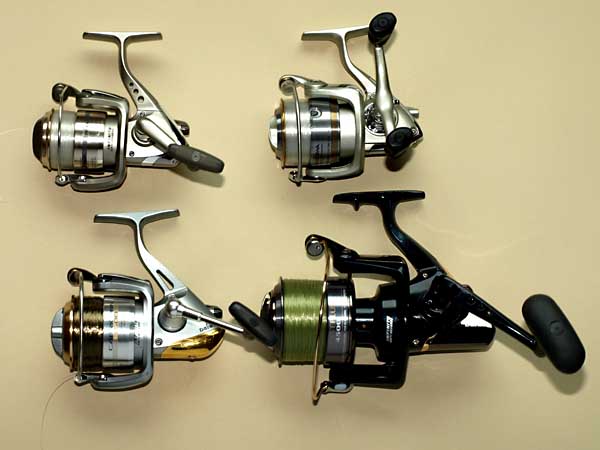
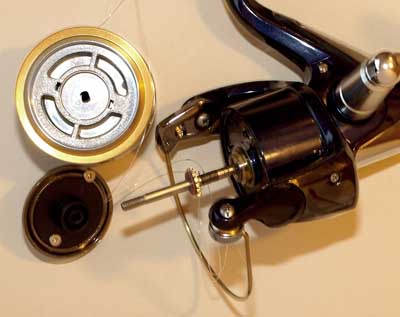 In the picture you see some of my front drag reels, all Daiwa make as it happens, and you can tell they are front drag reels by the missing knob on the back of the reel’s body. To change a spool you need to unscrew the drag control to the point where it and the spool can be taken off completely and then after pushing the replacement spool on the screw pin, start to screw on the drag control knob until it’s reasonably tight. Slacken it off then until you can pull line off the spool with sufficient force as you think a fish could exert.
In the picture you see some of my front drag reels, all Daiwa make as it happens, and you can tell they are front drag reels by the missing knob on the back of the reel’s body. To change a spool you need to unscrew the drag control to the point where it and the spool can be taken off completely and then after pushing the replacement spool on the screw pin, start to screw on the drag control knob until it’s reasonably tight. Slacken it off then until you can pull line off the spool with sufficient force as you think a fish could exert.
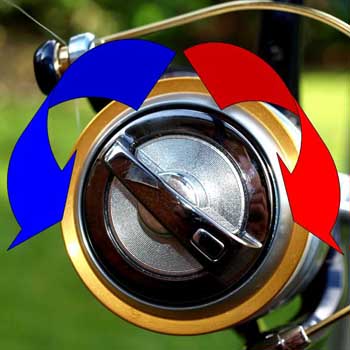 You can adjust the drag setting during a fight if you like by tightening it or slackening if off depending on whether you want to reel in line or give the fish more line. To tighten, turn the screw clockwise as you look down on it and to slacken off, turn the screw anti- clockwise. From behind, which you will be when fighting a fish, it will all be opposite, but it’s something you will get used to. Some anglers swear that front drag reels are more sensitive and easier to adjust because there are fewer parts involved in their make-up. The mechanics of the clutch in rear-drag reels, though, has vastly improved over the years and there is now little to chose between them.
You can adjust the drag setting during a fight if you like by tightening it or slackening if off depending on whether you want to reel in line or give the fish more line. To tighten, turn the screw clockwise as you look down on it and to slacken off, turn the screw anti- clockwise. From behind, which you will be when fighting a fish, it will all be opposite, but it’s something you will get used to. Some anglers swear that front drag reels are more sensitive and easier to adjust because there are fewer parts involved in their make-up. The mechanics of the clutch in rear-drag reels, though, has vastly improved over the years and there is now little to chose between them.
Sizes of Daiwa Reels
In the picture (top left) is a 2500 sized reel suitable for float fishing and light legering, although I have used this particular one for chub with a 1½ TC rod. Next along (top right) is a 3012 and although this has roughly the same size of body, the spool is bigger allowing you longer casts or if you are fishing with heavier feeder tackle. On the bottom row (left) is the 3500 size and this is also similar to the 4000 size, these are suitable for heavier fishing, say barbel and carp. Finally (bottom right), this is a large pit reel, the 4500 (although they do some much bigger still), suitable for really long casts and carp or pike fishing.
So for a float rod, you would probably want reels with a 2000-3000 designation and for heavier feeder rods 3000-4000. Big chub, bream and barbel might demand a 3500 at least, but all of this depends on what you think should suit the rod as well. It would be silly to put a very large reel on a float rod and equally silly to put a 2000 reel on a big hefty carp rod.
Rear Drag Reels
You will know these instantly when you see they have a knob on the back, but wait, don’t be fooled because there are some makes of reel that are front drag, but still have a knob on the back! This back knob is sometimes only to set the free runner, but more on that later.
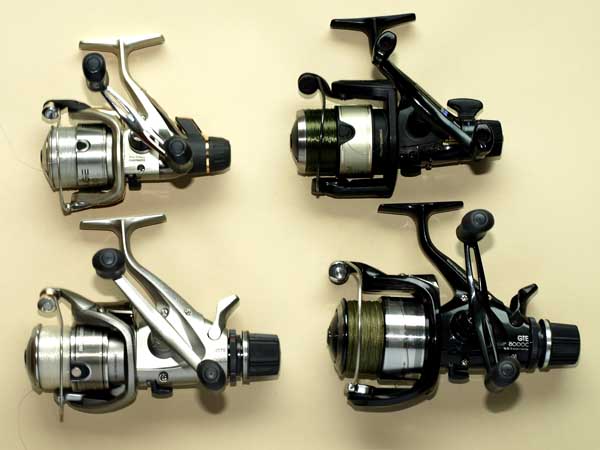
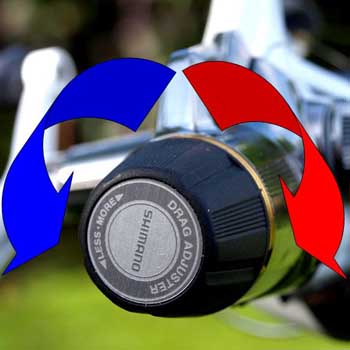 All the knob does on a rear drag reel is to tighten and slacken the drag, the spool is normally removed by a push button. So looking from behind this time, if you turn the drag knob clockwise it will tighten the drag and if you turn it anti-clockwise, it will slacken off the drag. Sounds simple, but that’s not all there is to it – at times.
All the knob does on a rear drag reel is to tighten and slacken the drag, the spool is normally removed by a push button. So looking from behind this time, if you turn the drag knob clockwise it will tighten the drag and if you turn it anti-clockwise, it will slacken off the drag. Sounds simple, but that’s not all there is to it – at times.
This is because a great many reels now have a drag lever also, Shimano call it their “Fighting Drag”. You’ll find the lever just in from of the drag knob and the way to use it is as thus. Push the drag lever to it’s upright position, which is normally the central position, and the set the drag to a point where you think your target fish could take line with a fairly hard pull. Push the lever to the left (as in the picture below) and it slackens off the drag a little, push it way over to the right and it tightens to drag to almost full on.
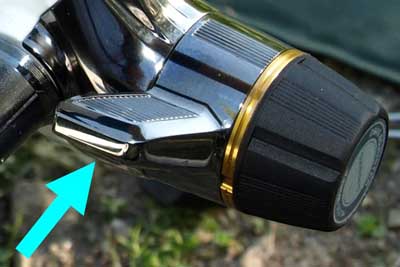 |
| Fighting Drag lever |
When fighting a fish this is the most useful way of adjusting the drag quickly and with the assurance that (with experience) you have the drag set exactly where you want it. It’s a far easier method rather than relying on a knob which doesn’t tell you by feel how hard it’s set on. This is one reason a lot of anglers are purchasing reels of this type.
Baitrunners and Free Runners, Free Spool et al
All the same, it’s just that “Baitrunner” is the brand name of Shimano (both reels in bottom row of picture) and it was they who developed it so all other manufacturers have to find themselves another term. All this type of reel allow you to do is the set the drag twice, effectively. Once for fighting the fish and a second drag to allow line to freely pay off when fishing for larger species that have a tendency to run/bolt with the bait – hence baitrunner, see?
The second drag feature is put into play by pushing forward a lever, this should be done after the casting and tightening up of all slack line and hanging any bite indicators etc. Once the lever is set, the second much slacker drag is in play and any bolting fish can take line freely off the spool, but half a quick turn of the reel handle and the lever will reset itself bringing the first and main drag back into play again. Most carp reels are now like this other than some big pit reels.
Remember I said ‘don’t be fooled’? Well, with some reels the back knob just adjusts the second drag that allows the fish to run, the main drag control is still the one on the front. These take a bit of getting used to whereas with Shimanos, the second drag is set by a much smaller dial just in front of the main rear drag knob.
It may all sound confusing, but it’s not rocket science and whichever reels you buy, you will soon get used to the features it has.
Sizes of Shimano Reels
OK, so in the picture (top left) is a 2500 and just like a Daiwa 2500 it will suit general float fishing through to medium feeder fishing. Next (top right) you see a 4000 which would normally be used for heavy float and heavy feeder fishing, possibly barbel and light carp. On the bottom row are two of Shimano’s baitrunners, the 5000 left for barbel and small to medium carp, and the 8000 right that will catch large carp. Shimano also do a 10,000 baitrunner and several big pit models if you want long casting as well.
Closed Face Reels
When working, these show no external signs of movement other than the reel handle turning, everything is internal and shrouded in metal. The originators of this type were Abu and despite many attempts by different manufacturers over the years, only Daiwa appear to offer an alternative. The big benefit of these reels is they perform brilliantly in the face of a wind when other fixed spool reels would get you in knots, but they are mainly only used for trotting a float these days.
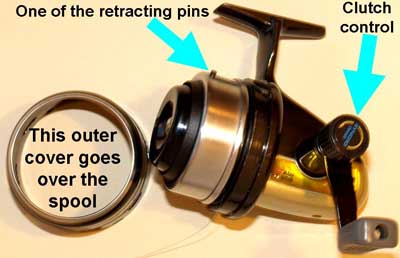 To release line ready for the cast, you push your finger down on the central button covering the front spool, what looks like a drag control, this retracts one or two pins (depending on model) that direct the line to the spool, to release the line to your finger. To reel in following a cast, just turn the handle and the pins are released out again catching the line and directing it to the spool.
To release line ready for the cast, you push your finger down on the central button covering the front spool, what looks like a drag control, this retracts one or two pins (depending on model) that direct the line to the spool, to release the line to your finger. To reel in following a cast, just turn the handle and the pins are released out again catching the line and directing it to the spool.
The entire mechanism is covered with an aluminium cover, through which the line appears, that in itself directs line onto the pins, but mostly it stops line flying off all over the place. Quite neat really if a little difficult to grasp at first.
The drags on these are different between Abu and Daiwa, I can only relate to the Abus as I’ve been using them for well over 40 years now and I have never owned a Daiwa closed face. I believe the drag on the Daiwa works exactly like a rear drag reel as described above. On the Abu, the drag (clutch) is set by the knob on the handle.
Turn it anticlockwise and it slackens off the drag, clockwise and it tightens it. But here’s the trick, with the anti-reverse switch set, turn the handle backwards slightly and the drag slackens off to an even greater extent, wind forward again under pressure and it returns to how you first set it. It’s a nice little feature call “Syncro”, useful!
General
These are the basic types of fixed spool reels you are likely to find, there are some speciality reels, big pits etc., that have some modified front drags to incorporate a freerunner feature, but by the time a newcomer gets into these they’ll be well aware of all the parts and what they do.
All this talk of drags (clutches, if you like) and frankly, some people just don’t like them or trust them so instead of messing about with setting knobs and screws, they simply use backwind. Set to anti-reverse of the reel off and away you go, if you like that, but drags are now ultimately far better than they ever were and it’s well worth getting to know them.
Match reels: you will often see these advertised and wonder how they differ from normal reels. Well, in simple terms all they have are either faster retrieve ratios and/or an extra spool and the spools may be shallow to take less line, making them better for lighter lines up to 6lbs, say. Other than that, they operate in much the same way and have the very same features as above.
Here’s the really important point, I’ve concentrated largely on Daiwa and Shimano and that’s just because those are the fixed spool reels I have bought and use. There are many other cracking examples of good reels out there, but they will all have some or all of the features you see above. This is just a guide as to what to look for and how to use them.










